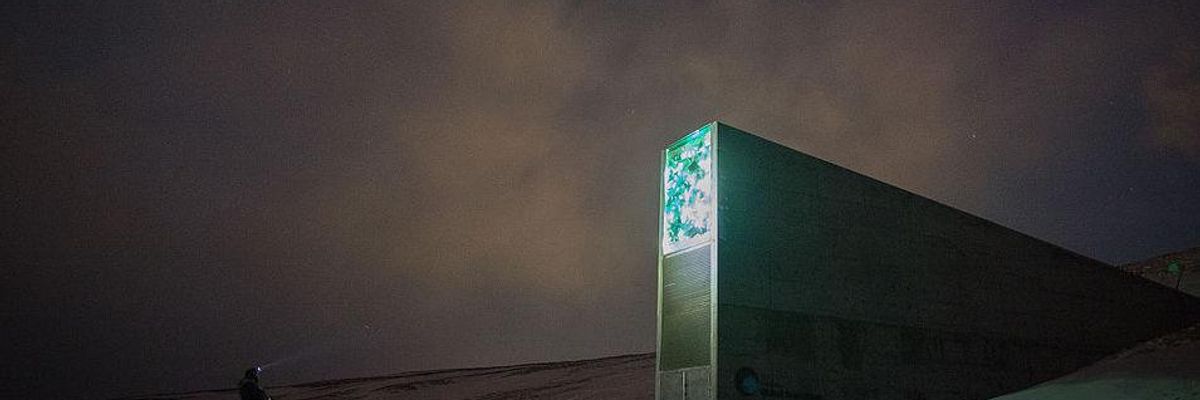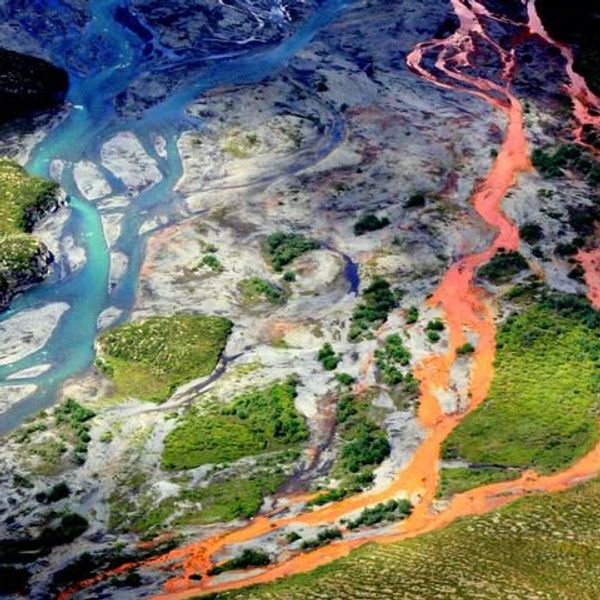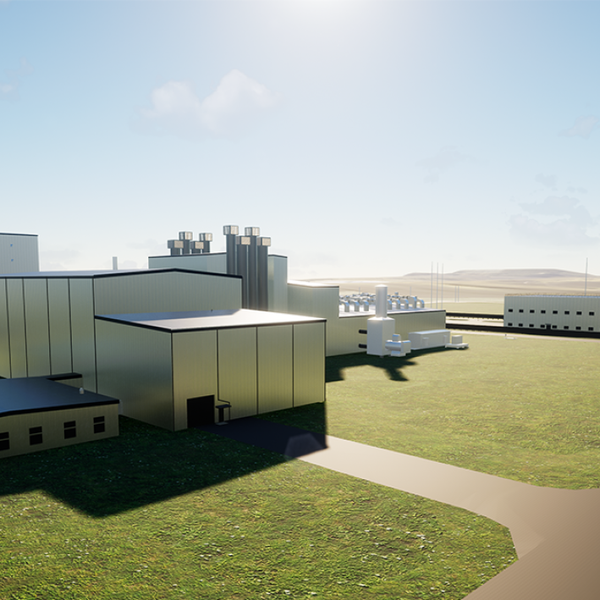
Dusk at the Svalbard Global Seed Vault.
'We Can't Trust the Permafrost Anymore': Doomsday Vault at Risk in Norway
"Not good."
Just over a decade after it first opened, the world's "doomsday vault" of seeds is imperiled by climate change as the polar region where it's located warms faster than any other area on the planet.
The Svalbard Global Seed Vault, which opened in late February 2008, was built by the organization Crop Trust and the Norwegian government on the island of Svalbard next to the northernmost town in the world with more than 1,000 residents, Longyearbyen.
"Svalbard is the ultimate failsafe for biodiversity of crops," said Crop Trust executive director Marie Haga.
Northern temperatures and environment on the island were a major reason for the construction. According to in-depth reporting from CNN, the project planners hoped that the permafrost around the construction of the underground vault would, in time, refreeze. But the planet has other plans.
Longyearbyen and, by extension, the vault, is warming more rapidly than the rest of the planet. That's because the polar regions of Earth--the coldest areas on the planet--are less able to reflect sunlight away from the polar seas due to disappearing ice and snow cover.
\u201c'Doomsday vault' town warming faster than any other on Earth: 3.7 degrees Centigrade warming already in this Arctic town. Permafrost melting. Buildings sinking. https://t.co/oFLGjNyhad\u201d— John Raymond Hanger (@John Raymond Hanger) 1553685634
It's an ironic turn of events for the creators of the vault, who chose the location for the vault "because the area is not prone to volcanoes or earthquakes, while the Norwegian political system is also extremely stable,'" said CNN.
Because of the warming, the permafrost around the underground vault's tunnel entrance has not refrozen. That led to leaking water in the tunnel in October 2016, which then froze into ice.
In response, CNN reported, "Statsbygg [the Norwegian state agency in charge of real estate] undertook 100 million Norwegian krone ($11.7 million) of reconstruction work, more than double the original cost of the structure."
But the warming now may become unsustainable for the structure. It's already forcing changes to Longyearbyen's population of 2,144 as the people in the town find themselves scrambling to avoid avalanches and deal with a changing climate that's more often dumping rain rather than snow.
"We can't trust the permafrost anymore," said Statsbygg communications manager Hege Njaa Aschim.
British advocacy group Global Citizen was more to the point.
"Not good," the group tweeted.
\u201cNot good. https://t.co/8qSmzYGD1P\u201d— Global Citizen UK (@Global Citizen UK) 1553699038
An Urgent Message From Our Co-Founder
Dear Common Dreams reader, The U.S. is on a fast track to authoritarianism like nothing I've ever seen. Meanwhile, corporate news outlets are utterly capitulating to Trump, twisting their coverage to avoid drawing his ire while lining up to stuff cash in his pockets. That's why I believe that Common Dreams is doing the best and most consequential reporting that we've ever done. Our small but mighty team is a progressive reporting powerhouse, covering the news every day that the corporate media never will. Our mission has always been simple: To inform. To inspire. And to ignite change for the common good. Now here's the key piece that I want all our readers to understand: None of this would be possible without your financial support. That's not just some fundraising cliche. It's the absolute and literal truth. We don't accept corporate advertising and never will. We don't have a paywall because we don't think people should be blocked from critical news based on their ability to pay. Everything we do is funded by the donations of readers like you. Will you donate now to help power the nonprofit, independent reporting of Common Dreams? Thank you for being a vital member of our community. Together, we can keep independent journalism alive when it’s needed most. - Craig Brown, Co-founder |
Just over a decade after it first opened, the world's "doomsday vault" of seeds is imperiled by climate change as the polar region where it's located warms faster than any other area on the planet.
The Svalbard Global Seed Vault, which opened in late February 2008, was built by the organization Crop Trust and the Norwegian government on the island of Svalbard next to the northernmost town in the world with more than 1,000 residents, Longyearbyen.
"Svalbard is the ultimate failsafe for biodiversity of crops," said Crop Trust executive director Marie Haga.
Northern temperatures and environment on the island were a major reason for the construction. According to in-depth reporting from CNN, the project planners hoped that the permafrost around the construction of the underground vault would, in time, refreeze. But the planet has other plans.
Longyearbyen and, by extension, the vault, is warming more rapidly than the rest of the planet. That's because the polar regions of Earth--the coldest areas on the planet--are less able to reflect sunlight away from the polar seas due to disappearing ice and snow cover.
\u201c'Doomsday vault' town warming faster than any other on Earth: 3.7 degrees Centigrade warming already in this Arctic town. Permafrost melting. Buildings sinking. https://t.co/oFLGjNyhad\u201d— John Raymond Hanger (@John Raymond Hanger) 1553685634
It's an ironic turn of events for the creators of the vault, who chose the location for the vault "because the area is not prone to volcanoes or earthquakes, while the Norwegian political system is also extremely stable,'" said CNN.
Because of the warming, the permafrost around the underground vault's tunnel entrance has not refrozen. That led to leaking water in the tunnel in October 2016, which then froze into ice.
In response, CNN reported, "Statsbygg [the Norwegian state agency in charge of real estate] undertook 100 million Norwegian krone ($11.7 million) of reconstruction work, more than double the original cost of the structure."
But the warming now may become unsustainable for the structure. It's already forcing changes to Longyearbyen's population of 2,144 as the people in the town find themselves scrambling to avoid avalanches and deal with a changing climate that's more often dumping rain rather than snow.
"We can't trust the permafrost anymore," said Statsbygg communications manager Hege Njaa Aschim.
British advocacy group Global Citizen was more to the point.
"Not good," the group tweeted.
\u201cNot good. https://t.co/8qSmzYGD1P\u201d— Global Citizen UK (@Global Citizen UK) 1553699038
Just over a decade after it first opened, the world's "doomsday vault" of seeds is imperiled by climate change as the polar region where it's located warms faster than any other area on the planet.
The Svalbard Global Seed Vault, which opened in late February 2008, was built by the organization Crop Trust and the Norwegian government on the island of Svalbard next to the northernmost town in the world with more than 1,000 residents, Longyearbyen.
"Svalbard is the ultimate failsafe for biodiversity of crops," said Crop Trust executive director Marie Haga.
Northern temperatures and environment on the island were a major reason for the construction. According to in-depth reporting from CNN, the project planners hoped that the permafrost around the construction of the underground vault would, in time, refreeze. But the planet has other plans.
Longyearbyen and, by extension, the vault, is warming more rapidly than the rest of the planet. That's because the polar regions of Earth--the coldest areas on the planet--are less able to reflect sunlight away from the polar seas due to disappearing ice and snow cover.
\u201c'Doomsday vault' town warming faster than any other on Earth: 3.7 degrees Centigrade warming already in this Arctic town. Permafrost melting. Buildings sinking. https://t.co/oFLGjNyhad\u201d— John Raymond Hanger (@John Raymond Hanger) 1553685634
It's an ironic turn of events for the creators of the vault, who chose the location for the vault "because the area is not prone to volcanoes or earthquakes, while the Norwegian political system is also extremely stable,'" said CNN.
Because of the warming, the permafrost around the underground vault's tunnel entrance has not refrozen. That led to leaking water in the tunnel in October 2016, which then froze into ice.
In response, CNN reported, "Statsbygg [the Norwegian state agency in charge of real estate] undertook 100 million Norwegian krone ($11.7 million) of reconstruction work, more than double the original cost of the structure."
But the warming now may become unsustainable for the structure. It's already forcing changes to Longyearbyen's population of 2,144 as the people in the town find themselves scrambling to avoid avalanches and deal with a changing climate that's more often dumping rain rather than snow.
"We can't trust the permafrost anymore," said Statsbygg communications manager Hege Njaa Aschim.
British advocacy group Global Citizen was more to the point.
"Not good," the group tweeted.
\u201cNot good. https://t.co/8qSmzYGD1P\u201d— Global Citizen UK (@Global Citizen UK) 1553699038

